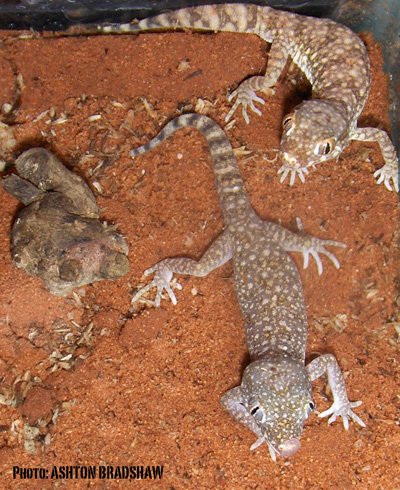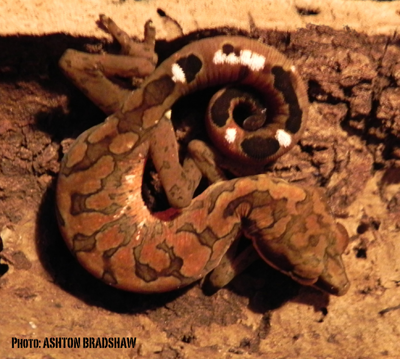Behind the curtain of captive husbandry, one gecko species thrives, while another will not. To understand the species, their environment, anatomy and biology, must further studied. All animals have species-specific needs. Some needs are minimal some are greatly complex. Some needs are obvious while others are obscure and unknown. However these needs must be met to provide health, a quality life, and comfort for captive geckos.
In captive populations, the more specific needs of many species are often not met, or are treated with wrong, careless, and lazy attempts. Often an owner’s preference of style and look of an enclosure prevents correct husbandry. For some it is most important to simply own and cost efficiently breed a species. Many species cannot survive the resulting conditions. Whatever the reason, animals rely on appropriate environmental conditions to maintain the integrity of their biological and anatomical functions. In captivity this translates to a simulation their existence in the wild. This may come in the form of a properly constructed vivarium, proper nutrient supplementation, and a wide range of other factors. The natural conditions of a species in the wild should be studied at least as much as the species itself.
SIMPLICITY VS. DIVERSITY: Too Much and Not Enough

Many terrestrial desert-dwelling Australian geckos from genera such as Nephrurus and Diplodactylus will survive and procreate under very simple captive conditions. A simple box of sand in which to bury themselves, a steady supply of food, hydration, and correct temperatures are virtually all that’s needed. Of course their natural habitat is more diverse than this, it is just that the niche they have filled in the wild relies only on a small portion of the greater ecosystem. The result is that the animal seeks what it needs from the environment and neglects many extraneous factors. A large tree is not a survival necessity for the species of gecko from the genus Stenodactylus even though its natural environment contains large trees. By contrast, this is not the case for the majority of species occurring in rainforests. Wild caught species from rainforest ecosystems rely on a great diversity of plants, microorganisms, and environmental factors, even in captivity. In many cases these are life or death needs. An exception to this often occurs in the well-established, captive bred populations. Although the rainforest ecosystems of New Caledonia are diverse and complex, Rhacodactylus geckos do well in captivity even with minimal natural furnishings. This is likely due to their adaptation to a simpler environment through time and mass captive breeding efforts. Also, some species are much more capable of adapting than others.
THE NEED “TO BE”: The Morphology and Psychology of Camouflage Artists

The entire genus of Uroplatus provides many great examples of an animal’s morphological relation their particular ecosystems. Uroplatus contains one of the largest groups of naturally occurring polymorphic species. Each species within itself contains countless morphological and color variations. A reason for Uroplatus phantasticus, the Fantastic Leaf-tailed Gecko, displaying great morphological differences is in part due to the great variety of habitats in which they’re found. Individuals from drier locales appear different from those in more humid locales. Also groups from different elevations display different characteristics. The husbandry of these geckos enters another dimension of need when you consider the psychology of a camouflage artist. This psychology directly affects their hunting techniques, sleeping, hiding, basking, and overall behavior and health.
The relationship of Uroplatus fimbriatus, the Giant Leaf-tailed Geckos, to trees of their region encompasses a great portion of their lives. The vertical trunk of sapling trees allows them disguise themselves while basking, hunting, and sleeping. U. fimbriatus geckos rely on the tree bark’s pattern and texture, as well as the lichens and mosses, to disguise themselves and fashion their offspring. On the cellular level their pattern is capable of slight changes to match the surface upon which they position themselves. In captivity these geckos cannot carry out the type of life they are used to without the environmental props that aid them in nature. For this reason, wild caught individuals have an even greater difficulty adapting to captivity than captive bred specimens.
Uroplatus phantasticus has a similar morphological and behavioral relationship with the leaves of shrubs and other plants within their particular regions. Once they are aware of being noticed, U. phantasticus will often sway back and forth like a leaf in the wind as a passive defense mechanism. When attacking prey from a height, they will fall to the ground and roll over like a leaf. This behavior is especially important in the wild where natural predators are common. Providing such features needed for these species to effectively perform their biological functions will increase the success of care and breeding in captivity.
BIOLOGICAL & ENVIRONMENTAL PHENOMENA: Cat Geckos

Some species have to cope with extreme environmental phenomena, which are unique to their particular locality. Aeluroscalabotes felinus ssp., the Cat Gecko, is subject to monsoon seasons in their natural range. The silver eyed Johor locale, the green-eyed Borneo species (Aeluroscalabotes cf. dorsalis), as well as other poorly understood Cat geckos are also subject to Southeast Asia’s two monsoon seasons. This section will cover the Malaysian Cameron Highlands locale (Aeluroscalabotes felinus) due to its increasing presence in the trade at this time. Though in a mountainous region, this species is affected by the Southwest monsoon season in from September through November. However February is a relatively dry and warm month. The breeding cycles of these geckos are likely dependent upon the timing of the monsoons. Reason being is that A. felinus is found in riparian (i.e. In the margin between land and water bodies) Gallery forests. Flooding and landslides are common in this region. The changing topography of their habitat affects their lifestyle as well the safety of their egg deposition sites. It has been noted in captivity that wild caught individuals typically breed some time after the monsoon season would have ended in their natural range. This is likely due to the re-stabilization of the landscape as well as their biological clocks response to this time.
Also, Cat Geckos are one of the few species subject to getting kidney stones in captivity. The biology surrounding this is still poorly researched and only simple means of treating this problem have been applied. The fact that they are found at high elevations, where water sources have not yet accumulated the mineral content found in lower elevation water sources, may explain their extreme mineral sensitivity. The kidney stones will generally cease if distilled and or reverse osmosis water is used. Only occasional supplementation of their food with calcium/vitamins/minerals is suggested.
WHAT ELSE COULD IT BE?
When dealing with poorly understood or infamously difficult species to keep, it can be difficult to isolate a specific need that is not being met. Prey item variety is often more limited in captivity than in the wild. Some species may prefer an array of insects with a more diverse chemical makeup. However some species’ diets consist of a single type of foreign (to captive populations) prey or one that behaves in a particular way (many roaches’ behavior is preferred by Uroplatus of the henkeli complex). Also certain pro-biotics in the digestive tract picked up in the wild may play an important role in an animal’s digestion and consequently would affect eating habits and health in captivity. Other factors to be investigated when dealing with difficult species may include: air flow, sleeping habits and location, size of territory, plants of great importance, levels of UV radiation, altitude/oxygen levels, circumstances surrounding egg deposition, what surfaces are preferred for sleep/hunting/basking, pH levels in soil and water, and human activity, amongst many others.
CONCLUSION
Thorough research of a species’ biology, anatomy, behavior and placement in its natural ecosystem will be most helpful in understanding the intricacies surrounding its needs. Applying natural conditions in captivity will provide a quality life for the animal and success for the keeper. Captive bred individuals intrinsically have an easier time relating to their captive environment. So when possible it is best to acquire captive bred (CB) geckos. Continuing the breeding effort, so that the herp trade relies less and less on imported animals, should be a goal of all. Documenting and sharing knowledge, the way keepers do, will continue to provide a service to the geckos and those they share their lives with.
[ad#sponsor]


Thanks for the great article, Ashton. What a great topic to cover!
Thanks for the excellent article, Ashton After reading your article, it makes sense to follow your advice to acquire only captive bred geckos.
Thanks very much, Ashton. Well thought out article. Useful and helpful.
Keep up the good work!
Melissa
I live in Brazil and I really enjoyed your website it helps a lot in the creators!! hugs
Appreciate the recommendation. Will try it out.|